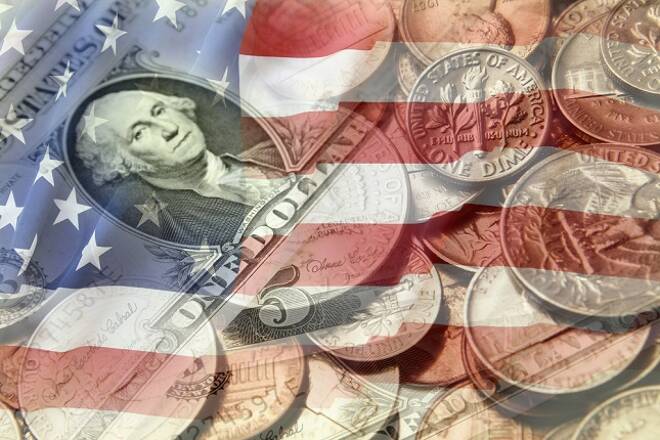Advertisement
Advertisement
Corporate Earnings and U.S GDP Numbers Keep the USD in Focus
By:
Corporate earnings and U.S GDP numbers will keep the markets busy later today. Risk appetite could be tested if the U.S economy sees sub-2% growth...
Earlier in the Day:
The economic calendar was on the busier side through the Asian session this morning.
Key stats included March trade figures out of New Zealand, April inflation, retail sales and industrial production figures out of Japan. For the Aussie Dollar, wholesale inflation numbers were released.
For the Kiwi Dollar,
According to NZStats, the annual trade deficit narrowed from NZ$6,620m to NZ$5,620m in March. Rising exports and a fall in imports led to better than forecasted trade figures.
- Exports hit a record high in March, rising by NZ$899m (19%) to NZ5.7bn. Higher exports of dairy, meat and forestry products, from China, in particular, drove exports.
- In contrast, the total value of imports fell by NZ$174m (-3.5%) to NZ$4.8bn.
- The monthly trade surplus widened from NZ$12m to NZ$922m in March, the highest since April 2011.
- While the monthly trade surplus hit an 8-year high, the annual trade deficit of NZ$5,620m remains at high levels.
The Kiwi Dollar moved from $0.66327 to $0.66340 upon release of the figures. At the time of writing, Kiwi Dollar was up 0.23% to $0.6641 for the session.
For the Japanese Yen,
Tokyo core consumer prices rose by 1.3% in April, which was better than a forecasted and March 1.1% increase.
According to figures released by the Ministry of Internal Affairs and Communication,
- Rising prices for fuel, light and water charges (+6.4%), furniture and household utensils (+3.2%) and culture and recreation (+2.6%) contributed to the pickup in inflationary pressure.
- A 0.5% fall in prices for transportation and communication was the only negative number in April.
- Also dragging on inflation was a 0.5% rise in prices for housing, a 0.7% rise in prices for education and a 0.8% rise in prices medical care.
Retail sales rose by 1%, coming in ahead of a forecasted 0.8% increase. In February, retail sales rose by 0.6%. The figures were released by the Ministry of Economy, Trade and Industry.
Industrial production fell by 0.9% in March, according to prelim figures released by Ministry of Economy, Trade and Industry,
- Industries that mainly contributed to the decrease were: Motor vehicles; production machinery; and fabricated metals.
- Industries that mainly contributed to an increase were: Electronic parts and devices; general-purpose and business-oriented machinery; and inorganic and organic metals.
The Japanese Yen moved from ¥111.555 to ¥111.510 upon release of the figures. At the time of writing, the Japanese Yen was flat at ¥111.63 against the U.S Dollar
For the Aussie Dollar,
Wholesale prices rose by 0.4% in the 1st quarter from the 4th quarter. While in line with forecasts, inflation softened from 0.5% in the 4th quarter. The annual rate of wholesale inflation stood at 1.9%, reflecting a softening in factory gate prices from the 4th quarter of 2018. Forecasts were for wholesale inflation to hold steady at 2%.
According to figures released by the ABS,
- The 0.4% increase was attributed to an increase in prices received for: Other agriculture (+10.3%); heavy and civil engineering construction (+0.4%) and tertiary education (+1.7%).
- Partially offsetting were falls in prices for Petroleum refining and petroleum fuel manufacturing (-3.1%); accommodation (-2.8%) and pharmaceutical and medical product manufacturing (-1.9%).
The Aussie Dollar moved from $0.70231 to $0.70171 upon release of the figures. At the time of writing, the Aussie Dollar was up 0.11% to $0.7023.
The Day Ahead:
For the EUR,
France’s jobseeker figures are the only stats due out of the Eurozone. The stats are unlikely to have a material impact on the EUR.
Market risk sentiment will continue to be the key driver, with recent economic data suggesting that ECB is likely to remain on the more dovish side near-term.
On the corporate earnings front, Deutsche Bank and Daimler are due to release earnings later this morning. Disappointing numbers could add further pressure on to the EUR.
At the time of writing, the EUR was up 0.04% at $1.1136.
For the Pound,
Mortgage approvals due out of the UK will unlikely have an impact on the Pound. The focus will remain on Parliament and Brexit, which continues to fuel uncertainty over what lies ahead.
At the time of writing, the Pound was up 0.03% to $1.2903.
Across the Pond,
1st quarter GDP numbers and finalized consumer sentiment figures are due out of the U.S.
The GDP numbers are not only expected to, reflect the effects of the extended government shutdown, but also the ongoing trade war with China.
Outside of the stats, U.S corporate earnings will also be in focus. Key earnings results include those for Chevron Corp. and Exxon Mobil Corp.
At the time of writing, the Dollar Spot Index was down by 0.06% to 98.147.
For the Loonie,
There are no material stats due out this afternoon, leaving the Loonie in the hands of crude oil prices and risk sentiment.
The Loonie was up 0.03% at C$1.3481, against the U.S Dollar, at the time of writing.
About the Author
Bob Masonauthor
With over 28 years of experience in the financial industry, Bob has worked with various global rating agencies and multinational banks. Currently he is covering currencies, commodities, alternative asset classes and global equities, focusing mostly on European and Asian markets.
Advertisement
